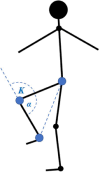Reliability and validity of computer vision-based markerless human pose estimation for measuring hip and knee range of motion
- PMID: 39897097
- PMCID: PMC11783685
- DOI: 10.1049/htl2.70002
Reliability and validity of computer vision-based markerless human pose estimation for measuring hip and knee range of motion
Abstract
Telerehabilitation requires accurate joint range of motion (ROM) measurement methods. The aim of this study was to evaluate the reliability and validity of a computer vision (CV)-based markerless human pose estimation (HPE) application measuring active hip and knee ROMs. For this study, the joint ROM of 30 healthy young adults (10 females, 20 males) aged 20-33 years (mean: 22.9 years) was measured, and test-retests were assessed for reliability. For validity evaluation, the CV-based markerless HPE application used in this study was compared with an identical reference picture frame. The intraclass correlation coefficient (ICC) for the CV-based markerless HPE application was 0.93 for active hip inner rotation, 0.83 for outer rotation, 0.82 for flexion, 0.82 for extension, and 0.74 for knee flexion. Correlations (r) of the two measurement methods were 0.99 for hip-active inner rotation, 0.98 for outer rotation, 0.87 for flexion, 0.85 for extension, and 0.90 for knee flexion. This study highlights the potential of a CV-based markerless HPE application as a reliable and valid tool for measuring hip and knee joint ROM. It could offer an accessible solution for telerehabilitation, enabling ROM monitoring.
Keywords: computer vision; patient rehabilitation; reliability; telemedicine.
© 2025 The Author(s). Healthcare Technology Letters published by John Wiley & Sons Ltd on behalf of The Institution of Engineering and Technology.
Conflict of interest statement
The authors declare no conflicts of interest.
Figures









References
-
- Lind, V. , Svensson, M. , Harringe, M.L. : Reliability and validity of a digital goniometer for measuring knee joint range of motion. Meas. Phys. Educ. Exercise Sci. 26(3), 191–198 (2022)
-
- Hynynen, P. , Häkkinen, H. , Hännikäinen, H. , Kangasperko, M. , Karihtala, T. , Keskinen, M. , et al.: The corecompetences of a physiotherapist. Suomen Fysioterapeutit. https://www.suomenfysioterapeutit.fi/wp‐content/uploads/2018/04/CoreComp... (2016). Accessed Dec 2023
-
- Russell, T.G. , Jull, G.A. , Wootton, R. : Can the Internet be used as a medium to evaluate knee angle? Manual Ther. 8(4), 242–246 (2003) - PubMed
-
- Liikavainio, T. , Lyytinen, T. , Tyrväinen, E. , Sipilä, S. , Arokoski, J.P. : Physical function and properties of quadriceps femoris muscle in men with knee osteoarthritis. Arch. Phys. Med. Rehabil. 89(11), 2185–2194 (2008) - PubMed
LinkOut - more resources
Full Text Sources

